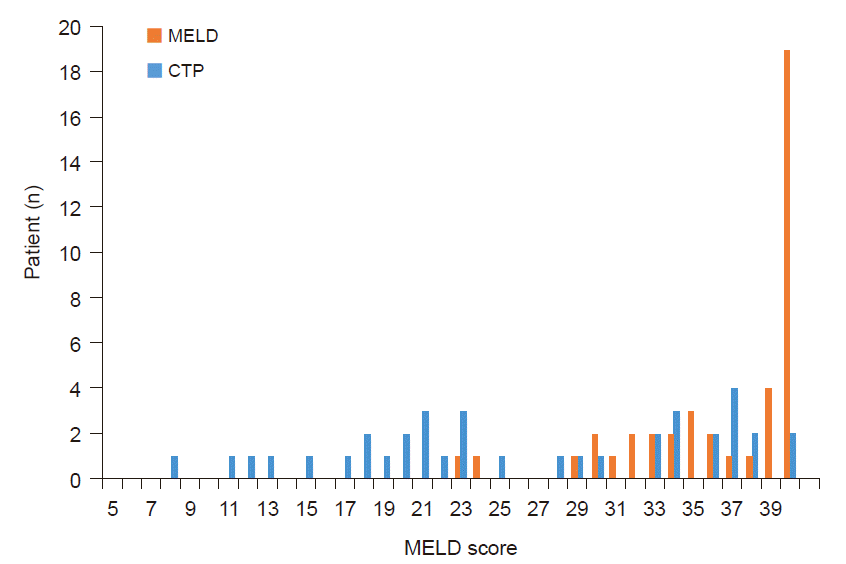1. KONOS. Korean law and regulation related with organ donation and transplantation. Ministry of Health and Welfare [serial on the Internet]. 2013 [cited 2014 Nov 5]. Available from:
http://www.konos.go.kr.
2. Wiesner RH, McDiarmid SV, Kamath PS, Edwards EB, Malinchoc M, Kremers WK, et al. MELD and PELD: application of survival models to liver allocation. Liver Transpl. 2001; 7:567–80.
3. Kim MS. Modification of emergency status in deceased donor liver allocation: evidence for Korean Model of End-stage Liver Disease (MELD) system. J Korean Soc Transplant. 2016; 30:51–8.
4. Dutkowski P, Oberkofler CE, Béchir M, Müllhaupt B, Geier A, Raptis DA, et al. The model for end-stage liver disease allocation system for liver transplantation saves lives, but increases morbidity and cost: a prospective outcome analysis. Liver Transpl. 2011; 17:674–84.
5. Bernardi M, Gitto S, Biselli M. The MELD score in patients awaiting liver transplant: strengths and weaknesses. J Hepatol. 2011; 54:1297–306.
6. Bang SR, Ahn HJ, Kim GS, Yang M, Gwak MS, Ko JS, et al. Predictors of high intraoperative blood loss derived by simple and objective method in adult living donor liver transplantation. Transplant Proc. 2010; 42:4148–50.
7. Gaies MG, Gurney JG, Yen AH, Napoli ML, Gajarski RJ, Ohye RG, et al. Vasoactive-inotropic score as a predictor of morbidity and mortality in infants after cardiopulmonary bypass. Pediatr Crit Care Med. 2010; 11:234–8.
8. Angeli P, Bezinover D, Biancofiore G, Bienholz A, Findlay J, Paugam Burtz C, et al. Acute kidney injury in liver transplant candidates: a position paper on behalf of the Liver Intensive Care Group of Europe. Minerva Anestesiol. 2017; 83:88–101.
9. Ginès P, Schrier RW. Renal failure in cirrhosis. N Engl J Med. 2009; 361:1279–90.
10. Kwon S. Hepatorenal syndrome. Clin Mol Hepatol. 2004; 10(3 Suppl):S57–66.
11. Kim HY, Lee JE, Ko JS, Gwak MS, Lee SK, Kim GS. Intraoperative management of liver transplant recipients having severe renal dysfunction: results of 42 cases. Ann Surg Treat Res. 2018; 95:45–53.
12. Oberkofler CE, Dutkowski P, Stocker R, Schuepbach RA, Stover JF, Clavien PA, et al. Model of end stage liver disease (MELD) score greater than 23 predicts length of stay in the ICU but not mortality in liver transplant recipients. Crit Care. 2010; 14:R117.
13. Massicotte L, Beaulieu D, Roy JD, Marleau D, Vandenbroucke F, Dagenais M, et al. MELD score and blood product requirements during liver transplantation: no link. Transplantation. 2009; 87:1689–94.
14. Massicotte L, Carrier FM, Karakiewicz P, Hevesi Z, Thibeault L, Nozza A, et al. Impact of MELD score-based organ allocation on mortality, bleeding, and transfusion in liver transplantation: a before-and-after observational cohort study. J Cardiothorac Vasc Anesth. 2019; 33:2719–25.
15. Varotti G, Santori G, Andorno E, Morelli N, Ertreo M, Strada P, et al. Impact of Model for End-Stage Liver Disease score on transfusion rates in liver transplantation. Transplant Proc. 2013; 45:2684–8.
16. Frasco PE, Poterack KA, Hentz JG, Mulligan DC. A comparison of transfusion requirements between living donation and cadaveric donation liver transplantation: relationship to model of end-stage liver disease score and baseline coagulation status. Anesth Analg. 2005; 101:30–7.
17. Lisman T, Porte RJ. Rebalanced hemostasis in patients with liver disease: evidence and clinical consequences. Blood. 2010; 116:878–85.
18. Lisman T, Porte RJ. Pathogenesis, prevention, and management of bleeding and thrombosis in patients with liver diseases. Res Pract Thromb Haemost. 2017; 1:150–61.
19. Henry Z, Northup PG. The rebalanced hemostasis system in end-stage liver disease and its impact on liver transplantation. Int Anesthesiol Clin. 2017; 55:107–20.
20. Hartmann M, Szalai C, Saner FH. Hemostasis in liver transplantation: pathophysiology, monitoring, and treatment. World J Gastroenterol. 2016; 22:1541–50.
21. Roullet S, Freyburger G, Cruc M, Quinart A, Stecken L, Audy M, et al. Management of bleeding and transfusion during liver transplantation before and after the introduction of a rotational thromboelastometry-based algorithm. Liver Transpl. 2015; 21:169–79.
22. Park SY. Viscoelastic coagulation test for liver transplantation. Anesth Pain Med (Seoul). 2020; 15:143–51.
23. Xia VW, Du B, Braunfeld M, Neelakanta G, Hu KQ, Nourmand H, et al. Preoperative characteristics and intraoperative transfusion and vasopressor requirements in patients with low vs. high MELD scores. Liver Transpl. 2006; 12:614–20.
24. Lee JA, Choi G, Kim JM, David Kwon CH, Joh JW. Comparison study of outcomes of deceased donor liver transplantation before and after Korean Model for End-Stage Liver Disease (MELD) system: single center experience. J Korean Soc Transplant. 2018; 32:7–11.
25. Gonwa TA, McBride MA, Anderson K, Mai ML, Wadei H, Ahsan N. Continued influence of preoperative renal function on outcome of orthotopic liver transplant (OLTX) in the US: where will MELD lead us? Am J Transplant. 2006; 6:2651–9.
26. Yadav SK, Saraf N, Saigal S, Choudhary NS, Goja S, Rastogi A, et al. High MELD score does not adversely affect outcome of living donor liver transplantation: experience in 1000 recipients. Clin Transplant. 2017; 31:e13009.





 PDF
PDF Citation
Citation Print
Print



 XML Download
XML Download